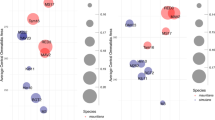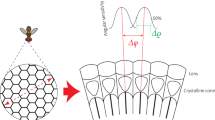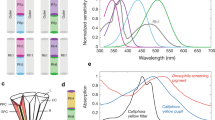Summary
The arrangements of ommatidia are charted and the visual fields of the compound eyes are plotted for both male and female of the dipteran speciesMusca domestica L.,Calliphora erythrocephala M.,Stomoxys calcitrans L.,Syritta pipiens L. andFannia fannia L. At the level of the retina remarkable differences between different species and between the sexes of one species exist. Consequences of the small binocular overlap area with respect to depth perception are discussed.
Similar content being viewed by others
References
Beersma, D.G.M., Stavenga, D.G., Kuiper, J.W.: Organization of visual axes in the compound eye of the flyMusca domestica L. and behavioural consequences. J, comp. Physiol.102. 305–320 (1975)
Braitenberg, V.: Patterns of projection in the visual system of the fly. I. Retina-lamina projections. Exp. Brain Res.3, 271–298 (1967)
Braitenberg, V.: Ordnung und Orientierung der Elemente im Sehsystem der Fliege. Kybernetik7, 235–242 (1970)
Braitenberg, V.: Periodic structures and structural gradients in the visual ganglia of the fly. In: Information processing in the visual systems of arthropods (ed. R. Wehner), p. 3–15. Berlin-Heidelberg-New York: Springer 1972
Braitenberg, V., Hauser-Holschuh, H.: Patterns of projection in the visual system of the fly. II. Qualitative aspects of second order neurons in relation to models of movement perception. Exp. Brain Res.16, 184–209 (1972)
Braitenberg, V., Strausfeld, N.J.: Principles of the mosaic organisation in the visual system's neuropil ofMusca domestica L. In: Handbook of Sensory Physiology VII/3 (ed. R. Jung), p. 631–659. Berlin-Heidelberg-New-York: Springer 1973
Buchner, E.: Dunkelanregung des stationären Flugs der FruchtfliegeDrosophila. Diplomarbeit, Tübingen 1971
Burkhardt, D., Darnhofer-Demar, B., Fischer, K.: Zum binokularen Entfernungssehen der Insekten. 1. Die Struktur des Sehraums von Synsekten. J. comp. Physiol.87, 165–188 (1973)
Collett, T.S., Land, M.F.: Visual control of flight behaviour in the hoverfly,Syritta pipiens L. J. comp. Physiol.99, 1–66 (1975a)
Collett, T.S., Land, M.F.: Visual spatial memory in a hoverfly. J. comp. Physiol.100, 59–84 (1975b)
Demoll, R.: Die Sinnesorgane der Arthropoden, ihr Bau und ihre Funktion. Braunschweig: Friedr. Vieweg & Sohn 1917
Dvorak, D.R., Bishop, L.G., Eckert, H.: Intracellular recording and staining of directionally selective motion detection neurons in fly optic lobe. Vision Res.15, 451–454 (1975)
Franceschini, N.: Sur le traitement optique de l'information visuelle dans l'oeil à facettes de la drosophile. Thèse. Grenoble 1972
Franceschini, N.: Sampling of the visual environment by the compound eye of the fly: Fundamentals and applications. In: Photoreceptor optics (eds. A.W. Snyder, R. Menzel), p. 98–125. Berlin-Heidelberg-New York: Springer 1975
Franceschini, N., Kirschfeld, K.: Etude optique in vivo des éléments photorécepteurs dans l'oeil composé deDrosophila. Kybernetik8, 1–13 (1971a)
Franceschini, N., Kirschfeld, K.: Les phénomènes de pseudopupille dans l'oeil composé deDrosophila. Kybernetik9, 159–182 (1971b)
Geiger, G.: Optomotor responses of the flyMusca domestica to transient stimuli of edges and stripes. Kybernetik16, 37–43 (1974)
Gemperlein, R.: Grundlagen zur genauen Beschreibung von Komplexaugen. Z. vergl. Physiol.65, 428–444 (1969)
Götz, K.G.: Movement discrimination in insects. In: Processing of optical data by organisms and machines. Rendiconti S.I.F., Vol. 43 (ed. W. Reichardt), pp. 494–509. London-New York: Pergamon Press 1969
Götz, K. G.: Processing of clues from the moving environment in theDrosophila navigation system. In: Information processing in the visual systems of arthropods (ed. R. Wehner), p. 255–263. Berlin-Heidelberg-New York: Springer 1972
Götz, K.G.. Wenking, H.: Visual control of locomotion in the walking fruitflyDrosophila. J. comp. Physiol.85, 235–266 (1973)
Kirschfeld, K.: Die Projektion der optischen Umwelt auf das Raster der Rhabdomere im Komplexauge vonMusca. Exp. Brain Res.3, 248–270 (1967)
Kirschfeld, K.: Aufnahme und Verarbeitung optischer Daten im Komplexauge von Insekten. Naturwiss.58, 201–209 (1971)
Kirschfeld, K.: The visual system ofMusca: Studies on optics, structure and function. In: Information processing in the visual systems of arthropods (ed. R. Wehner), p. 61–74. Berlin-Heidelberg-New York: Springer 1972
Kirschfeld, K., Franceschini, N.: Optische Eigenschaften der Ommatidien im Komplexauge vonMusca. Kybernetik5, 47–52 (1968)
Kirschfeld, K., Lutz, B.: Lateral inhibition in the compound eye of the fly,Musca. Z. Naturforsch.29c, 95–97 (1974)
Land, M.F., Collett, T.S.: Chasing behaviour of houseflies (Fannia canicularis). A description and analysis. J. comp. Physiol.89, 331–357 (1974)
McCann, G.D., Foster, S.F.: Binocular interactions of motion detection fibres in the optic lobes offlies. Kybernetik8, 193–203 (1971)
Reichardt, W.: Musterinduzierte Flugorientierung. Verhaltens-Versuche an der FliegeMusca domestica. Naturwiss.60, 122–138 (1973)
Stavenga, D.G.: Optical qualities of the fly eye — An approach from the side of geometrical, physical and waveguide optics. In: Photoreceptor optics (eds. A.W. Snyder, R. Menzel), p. 126–144. Berlin-Heidelberg-New York: Springer 1975a
Stavenga, D.G.: The neural superposition eye and its optical demands. J. comp. Physiol.102, 297–304 (1975b)
Stavenga, D.G., Beersma, D.G.M.: Formalism for the neural network of visual systems. Biol. Cybernetics19, 75–81 (1975)
Strausfeld, N.J.: The organization of the insect visual system (light microscopy) I. Projections and arrangements of neurons in the Lamina ganglionaris of Diptera. Z. Zellforsch.121, 377–441 (1971a)
Strausfeld, N.J.: The organization of the insect visual system (light microscopy). II. The projection of fibers across the first optic chiasma. Z. Zellforsch.121, 442–454 (1971b)
Strausfeld, N.J.: Atlas of an insect brain. Berlin-Heidelberg-New York: Springer 1976
Trujillo-Cenóz, O.: The structural organization of the compound eye in insects. In: Handbook of Sensory Physiology VII/2 (ed. M.G.F. Fuortes), p. 5–61. Berlin-Heidelberg-New York: Springer 1972
Author information
Authors and Affiliations
Rights and permissions
About this article
Cite this article
Beersma, D.G.M., Stavenga, D.G. & Kuiper, J.W. Retinal lattice, visual field and binocularities in flies. J. Comp. Physiol. 119, 207–220 (1977). https://doi.org/10.1007/BF00656634
Received:
Issue Date:
DOI: https://doi.org/10.1007/BF00656634




